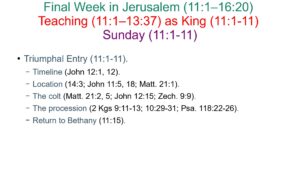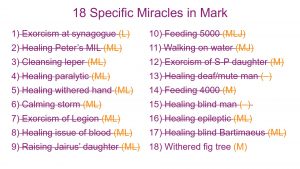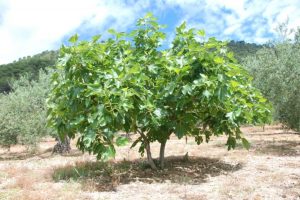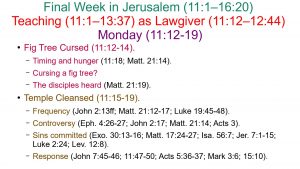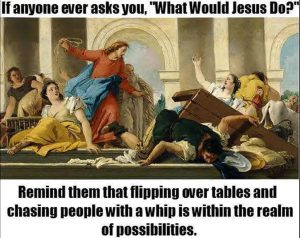Jesus’ Final Week in Jerusalem
Mark 11:1–16:20
Teaching (11:1–13:37)
King (11:1-11)
Sunday: Triumphal Entry (11:1-11).
Location.
The colt.
The procession.
This is probably the height of His popularity as He enters into Jerusalem.
Many people recognized Him to be the Messiah, though they were mistaken as to what that meant.
They thought He was coming in to usher a new era, expelling the Romans from Israel and reigning as an earthly king.
So they treated Him as royalty by spreading clothes and leafy branches before His path, like we would roll out the red carpet.
Jehu was given that treatment when he was told by Elisha’s servant that he was going to be king (2 Kings 9:11-13).
Jehu had the potential to be a great king of Israel, but he squandered it when he followed in the path of the wicked kings before him (2 Kings 10:29-31).
He destroyed the worshipers of Baal but propped up the idols at Dan and Bethel that King Jeroboam had set up.
King Jesus would live up to King Jehu’s potential.
The people cried out, “Hosanna!” which literally means “help!” or “save me!” but had come to be a simple cry of acclamation.
However, the literal meaning most certainly applies, particularly as they are alluding to Psalm 118, another Messianic Psalm (Psa. 118:26).
It cannot be overlooked that just a few verses earlier, the psalm states,
“The stone which the builders rejected
Has become the chief cornerstone.
This was the Lord’s doing;
It is marvelous in our eyes.
This is the day the Lord has made;
We will rejoice and be glad in it.
Save now [hoshiy’ah], I pray [‘anna’], O Lord;
O Lord, I pray, send now prosperity” (Psa. 118:22-25).As these chants reveal, they are expecting a conquering hero, not a bleeding Messiah.
But there is such expectation around Jesus, and the people are truly excited.
If you were in Jesus’ shoes, how would you feel about this praise and adulation? It would make me sad because I would know it wouldn’t last the week.
A lesser man might have tried riding this wave of glory and praise before it faded.
Instead Jesus humbly returned to Bethany.
Return to Bethany.
Jesus went into Jerusalem and the temple.
I think based on this, the road He took was the more northern one into the city.
Then He goes into the temple and looks around, no doubt noting the tables of the money changers (11:15).
Perhaps He went back to His lodging with that on His mind, praying about it, wondering the best course of action.
Some portray that event as a fit of uncontrolled anger on our Lord’s part, but that doesn’t fit His personality, does it?
No, He saw it first, likely considered His options, prayed about it, and then chose this as the best course of action.
But before any of that, He realized it was late (probably after 3, perhaps even after 6), and headed back to His lodging in Bethany with the Twelve.
Lawgiver (11:12–12:44)
Fig Tree Cursed (11:12-14).
Timing and hunger.
This occurs on the day after the triumphal entry, the day we call Monday, four days before the Passover.
Jesus is hungry, likely wanting to get to Jerusalem early that day, having skipped His breakfast.
Mark doesn’t record a lot of what happened on this day, but Matthew suggests He did a lot of miracles and healing this day (Matt. 21:14), while Mark also shows Him teaching (11:18).
It also happened not to be the season for figs.
As mentioned this was around the time of the Passover. For us that happens to be in the early to mid spring, sometime in March or April.
The season of figs is in June, so why did Jesus curse this fig tree?
It seems rather out of character for Jesus to do something like this.
But Jesus never did anything unless there was a lesson behind it, especially if it were recorded for us to read many years later.
So we always need to figure out what it was—it’s very unlikely that He would act so vindictive toward a plant for no reason.
We’ll talk more about the lesson that comes from this later, but for now, let us consider what Jesus was looking for.
Some contend that nowhere does it say Jesus was looking for figs, but was probably looking for buds instead.
Black citing Gundry states, “Jesus was looking for the buds which form just before and as the tree leafs. These buds may appear as early as March 1st, and although they are only marginally edible, people do eat them.”
Since there were no buds on this tree, Stauffer suggests that the purpose for the cursing was because the tree represented hypocrisy, something He had witnessed the day before in the temple that He was about to address by flipping some tables.
Matthew’s account suggests it withered immediately (Matt. 21:19).
Based on Mark’s account this shows that “immediately” doesn’t mean to us what it meant to them.
Mark often uses it as a transition, but it could very well be that this tree withered far more quickly than it would have naturally.
One day it was a vibrant tree with many leaves, the next it had withered away.
Compared to how it would have happened naturally, this is rather immediate.
In any event, the disciples heard this curse, and called it to Jesus’ attention the following day.
But before we talk about that, let us consider the event that is recorded in between the cursing and the lesson.
Temple Cleansed (11:15-19).
How many times?
Some contend that this event only occurred once, some twice, some even three times.
John records this happening, apparently early in His ministry (John 2:13ff).
Matthew, Mark, and Luke record it happening here (Matt. 21:12-17; Luke 19:45-48).
Those who say it only happened once argue that John wrote His account out of order.
It’s probable that some of the events that are recorded by each of the Gospel writers are written out of chronological order, but this seems a bit much.
Matthew suggests it happened on Sunday after Jesus rode into Jerusalem on the colt. Luke’s account suggests that, too, but he is a bit less clear on his timeline.
I have seen some timelines that suggest He did do it on Sunday, but did it again the following day, as Mark records.
It would appear that most scholars believe it occurred twice, the first recorded by John, the second by the others. I agree.
A controversial moment.
This is perhaps one of the most controversial moments in Jesus’ life.
It is used by Christians to justify all manner of ugliness toward one another and those outside the church as well.
 Maybe you’ve seen this meme before, and I do find it amusing.
Maybe you’ve seen this meme before, and I do find it amusing.But He didn’t just randomly fly off the handle at what was going on.
As we discussed, He had looked around the day before and had all night to think and pray about what His response was going to be.
He knew what was going on was wrong and knew it needed to be addressed.
We’ll talk about what was wrong in a moment, but first, I want to ask the question, How does this reconcile with other passages that say, “Be angry, and do not sin: do not let the sun go down on your wrath, nor give place to the devil” (Eph. 4:26-27)?
For one, I think we assume Jesus was angry here, but look at all four accounts, it never says anger played a role here. Zeal, sure, but that’s not the same as anger (John 2:17).
I suppose it’s hard to imagine someone flipping tables without being angry.
But it seems that His actions were deliberate, so the obvious question is why did He choose this method of correcting this behavior?
It could have been to get attention, though performing miracles could easily do that (Matt. 21:14; e.g. Acts 3).
It was the most efficient method of getting rid of the overtly sinful elements occurring right in front of Him.
He wanted to earn the ire of the elites who were benefiting from the sinful actions Jesus was trying to stop.
Of course, it could be any or all of these.
Such questions are important to consider because we may find ourselves asking if it’s appropriate to flip the tables and crack a whip—or more generally reacting in a violent, apparently unhinged manner.
Can you think of a situation that you were in where it was appropriate? If not, can you think of a hypothetical situation where it would be appropriate?
Honestly, I’m not sure I can. I think maybe the closest comparison would be if we were visiting a church and they started using a piano in worship. But most of us wouldn’t take an ax to the piano—we’d just up and leave.
